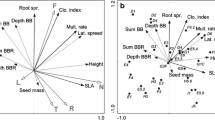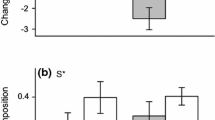Abstract
Understanding the links between intraspecific genetic variation and patterns of diversity in associated communities has been the primary focus of community genetics or ‘genes-to-ecosystem’ research in ecology. While other ecological factors, such as the abiotic environment, have well-documented influences on communities, the relative contributions of genetic variation versus the environment to species interactions remains poorly explored. In this study, we use a common garden experiment to study a coastal dune plant community dominated by the shrub, Baccharis pilularis, which displays a morphological dimorphism in plant architecture. We found the differences in the understory plant community between erect and prostrate morphs of Baccharis to be statistically significant, but small relative to the impacts of nutrient additions (NPK and C additions), for the richness, cover, and biomass of the understory plant community. There were no significant interactions between Baccharis morphology and nutrient-addition treatments, suggesting the influence of nutrient addition was consistent between erect and prostrate morphs. Moreover, we found no difference in overall plant community composition between Baccharis morphs, while NPK additions led to shifts in understory community composition compared to unfertilized shrubs. In sum, our results indicate that nutrients are the more important factor governing understory plant community structure in a coastal dunes ecosystem followed by intraspecific variation in dominant shrub architecture. Our results address a growing call to understand the extended consequences of intraspecific variation across heterogeneous environments in terrestrial ecosystems.


Similar content being viewed by others
References
Adams RI, Goldberry S, Whitham TG, Zinkgraf MS, Dirzo R (2011) Hybridization among dominant tree species correlates positively with understory plant diversity. Am J Bot 98:1623–1632
Alpert P, Maron JL (2000) Carbon addition as a countermeasure against biological invasion by plants. Biol Invasions 2:33–40
Baldwin B, Goldman D, Keil D, Patterson R, Rosatti T, Wilken D (eds) (2012) The Jepson manual: vascular plants of California, 2nd edn. University of California Press, Berkeley
Barbour MG, Craig RB, Drysdale FR, Ghiselin MT (1973) Coastal ecology: bodega head. University of California Press, Berkeley
Blumenthal DM, Jordan NR, Russelle MP (2003) Soil carbon addition controls weeds and facilitates prairie restoration. Ecol Appl 13:605–615
Booth RE, Grime JP (2003) Effects of genetic impoverishment on plant community diversity. J Ecol 91:721–730
Clarke KR, Gorley RN (2006) PRIMER v6: user manual/tutorial. PRIMER-E, Plymouth
Classen AT, Chapman SK, Whitham TG, Hart SC, Koch GW (2007) Genetic-based plant resistance and susceptibility traits to herbivory influence needle and root litter nutrient dynamics. J Ecol 95:1181–1194
Cohen J (1988) Statistical power analysis for the behavioral sciences. Lawrence Erlbaum Associates, Hillsdale, NJ
Crutsinger GM, Collins MD, Fordyce JA, Gompert Z, Nice CC, Sanders NJ (2006) Plant genotypic diversity predicts community structure and governs an ecosystem process. Science 313:966–968
Crutsinger GM, Strauss SY, Rudgers JA (2010) Genetic variation within a dominant shrub species determines plant species colonization in a coastal dune ecosystem. Ecology 91:1237–1243
Cushman JH, Waller JC, Hoak DR (2010) Shrubs as ecosystem engineers in a coastal dune: influences on plant populations, communities and ecosystems. J Veg Sci 21:821–831
Donaldson JR, Lindroth RL (2007) Genetics, environment, and their interaction determine efficacy of chemical defense in trembling aspen. Ecology 88:729–739
Ehler LE (1982) Ecology of Rhopalomyia californica Felt (Diptera: Cecidomyiidae) and its parasites in an urban environment. Hilgardia 50:1–32
Hersch-Green EI, Turley NE, Johnson MTJ (2011) Community genetics: what have we accomplished and where should we be going? Philos Trans R Soc B 366:1453–1460
Hughes AR, Inouye BD, Johnson MTJ, Underwood N, Vellend M (2008) Ecological consequences of genetic diversity. Ecol Lett 11:609–623
Hughes AR, Best RJ, Stachowicz JJ (2010) Genotypic diversity and grazer identity interactively influence seagrass and grazer biomass. Mar Ecol Prog Ser 403:43–51
Johnson MTJ, Agrawal AA (2005) Plant genotype and environment interact to shape a diverse arthropod community on evening primrose (Oenothera biennis). Ecology 86:874–885
Johnson MTJ, Dinnage R, Zhou AY, Hunter MD (2008) Environmental variation has stronger effects than plant genotype on competition among plant species. J Ecol 96:947–955
Knight KS, Oleksyn J, Jagodzinski AM, Reich PB, Kasprowicz M (2008) Overstorey tree species regulate colonization by native and exotic plants: a source of positive relationships between understory diversity and invasibility. Divers Distrib 14:666–675
Lamit LJ, Wojtowicz T, Kovacs Z, Wooley SC, Zinkgraf M, Whitham TG, Lindroth RL, Gehring CA (2011) Hybridization among foundation tree species influences the structure of associated understory plant communities. Botany 89:165–174
Lichter J (1998) Primary succession and forest development on coastal Lake Michigan sand dunes. Ecol Monogr 68:487–510
Maddox GD, Cappuccino N (1986) Genetic determination of plant susceptibility to an herbivorous insect depends on environmental context. Evolution 40:863–866
Maron JL, Connors PG (1996) A native nitrogen-fixing shrub facilitates weed invasion. Oecologia 105:302–312
Maun MA (2009) The biology of coastal sand dunes. Oxford University Press, Oxford
McLendon T, Redente EF (1992) Effects of nitrogen limitation on species replacement dynamics during early secondary succession on a semiarid sagebrush site. Oecologia 91:312–317
Michalet R, Xiao S, Touzard B, Smith DS, Cavieres LA, Callaway RM, Whitham TG (2011) Phenotypic variation in nurse traits and community feedbacks define an alpine community. Ecol Lett 14:433–443
Pierik M, van Ruijven J, Bezemer TM, Geerts RHEM (2011) Berendse F Recovery of plant species richness during long-term fertilization of a species-rich grassland. Ecology 92:1393–1398
Rudgers JA, Whitney KD (2006) Interactions between insect herbivores and a plant architectural dimorphism. J Ecol 94:1249–1260
Sanders NJ, Weltzin JF, Crutsinger GM, Fitzpatrick MC, Nunez MA, Oswalt CM, Lane KE (2007) Insects mediate the effects of propagule supply and resource availability on a plant invasion. Ecology 88:2383–2391
Smith MD, Wilcox JC, Kelly T, Knapp AK (2004) Dominance not richness determines invasibility of tallgrass prairie. Oikos 106:253–262
Souza L, Weltzin JF, Sanders NJ (2011) Differential effects of two dominant plant species on community structure and invasibility in an old-field ecosystem. J Plant Ecol 4:123–131
Tack AJM, Roslin T (2011) The relative importance of host-plant genetic diversity in structuring the associated herbivore community. Ecology 92:1594–1604
Thompson AE, Lee CW, Gass RE (1995) Development of hybrid Baccharis plants for desert landscaping. Hortic Sci 30:1357–1362
Vellend M, Drummond EBM, Tomimatsu H (2010) Effects of genotype identity and diversity on the invasiveness and invasibility of plant populations. Oecologia 162:371–381
Whitham TG, Bailey JK, Schweitzer JA et al (2006) A framework for community and ecosystem genetics: from genes to ecosystems. Nature Rev Genet 7:510–523
Acknowledgments
We thank two reviewers for their helpful comments and J. Sones at BMR for research assistance. G. M. C. was supported by the Miller Institute for Basic Research in Science, J. A. R. received support from the James H. and Deborah T. Godwin Professorship in the Natural Sciences. The experiments comply with the current laws of the United States of America.
Author information
Authors and Affiliations
Corresponding author
Additional information
Communicated by Alice Winn.
Electronic supplementary material
Below is the link to the electronic supplementary material.
Rights and permissions
About this article
Cite this article
Crutsinger, G.M., Carter, B.E. & Rudgers, J.A. Soil nutrients trump intraspecific effects on understory plant communities. Oecologia 173, 1531–1538 (2013). https://doi.org/10.1007/s00442-013-2727-3
Received:
Accepted:
Published:
Issue Date:
DOI: https://doi.org/10.1007/s00442-013-2727-3




